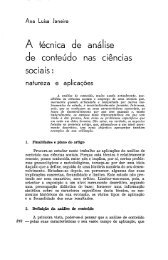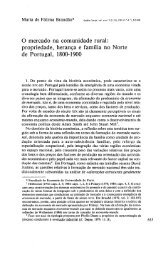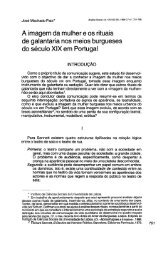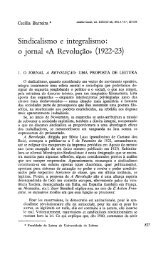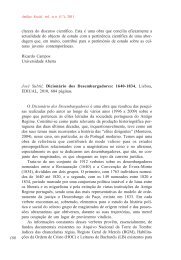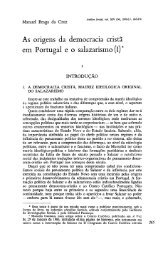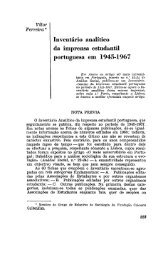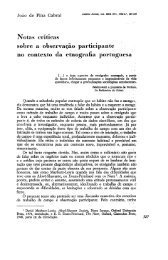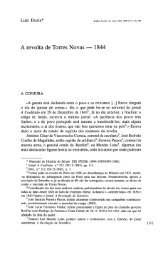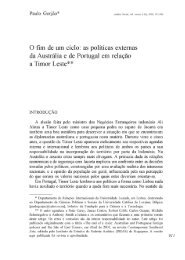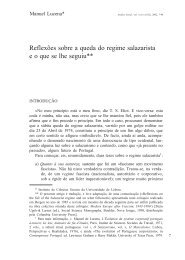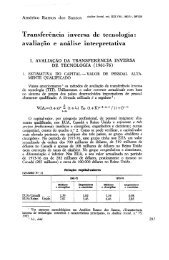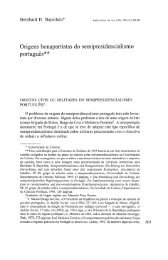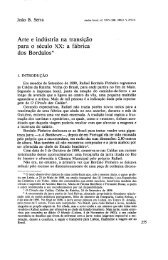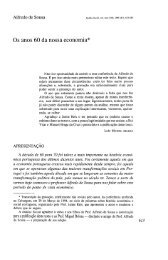ICS da UL - Análise Social - Universidade de Lisboa
ICS da UL - Análise Social - Universidade de Lisboa
ICS da UL - Análise Social - Universidade de Lisboa
You also want an ePaper? Increase the reach of your titles
YUMPU automatically turns print PDFs into web optimized ePapers that Google loves.
400<br />
Manuel Villaver<strong>de</strong> Cabral<br />
teoria marxista tradicional, apresenta entre nós os traços <strong>de</strong> uma «casta <strong>de</strong><br />
brâmanes»: forte auto-reprodução; estreita associação com a burguesia proprietária<br />
e dirigente; monopólio virtual sobre o escasso «capital escolar»<br />
disponível na socie<strong>da</strong><strong>de</strong> portuguesa. Na base do esquema figura, por sua vez,<br />
uma fracção ampla e consoli<strong>da</strong><strong>da</strong> <strong>de</strong> proletários <strong>de</strong> origem proletária, cujas<br />
origens relativamente homogéneas contrastam com a composição predominantemente<br />
heterogénea <strong>da</strong>s outras classes subordina<strong>da</strong>s <strong>da</strong> socie<strong>da</strong><strong>de</strong> portuguesa.<br />
Apesar disso, como veremos adiante, ambas as categorias manifestam<br />
clara dispersão atitudinal, o que <strong>de</strong>monstra a limita<strong>da</strong> capaci<strong>da</strong><strong>de</strong> explicativa<br />
<strong>da</strong>s posições <strong>de</strong> classe relativamente a muitas dimensões sociais.<br />
MOBILIDADE INTRAGERACIONAL<br />
No que diz respeito à mobili<strong>da</strong><strong>de</strong> intrageracional, verifica-se que ela é<br />
eleva<strong>da</strong>, sobretudo entre os homens (50%), embora previsivelmente inferior<br />
à mobili<strong>da</strong><strong>de</strong> intergeracional e apresentando os movimentos entre os diferentes<br />
agrupamentos <strong>de</strong> classe um padrão semelhante a esta última.<br />
[QUADRO IV]<br />
Próprio<br />
Classe I . . Ori g em • •<br />
Destino . .<br />
Classe II . . Oli g em • •<br />
Destino . .<br />
Classe III . Ori S em • •<br />
Destino . .<br />
Classe IV . Ori g em •<br />
Destino . .<br />
Classe V.. Ori 8 em • •<br />
Destino . .<br />
Classe VI . Ori S em • •<br />
Destino . .<br />
Total<br />
Oasse I<br />
13,3<br />
33,3<br />
2,4<br />
11,1<br />
1,1<br />
11,1<br />
1,2<br />
16,7<br />
2,4<br />
22,2<br />
—<br />
1,3<br />
Mobili<strong>da</strong><strong>de</strong> intrageracional<br />
(em percentagem)<br />
Classe II<br />
22,2<br />
10,3<br />
54,3<br />
67,7<br />
1,1<br />
2,1<br />
4,1<br />
11,3<br />
1,8<br />
3,1<br />
0,5<br />
3,1<br />
7,3<br />
Classe III<br />
11,1<br />
6,8<br />
2,4<br />
2,0<br />
28,4<br />
71,2<br />
1,2<br />
8,2<br />
2,4<br />
5,5<br />
1,0<br />
8,2<br />
5,5<br />
Pai<br />
Classe IV<br />
28,9<br />
5,3<br />
26,8<br />
14,1<br />
17,5<br />
13,0<br />
45,7<br />
42,7<br />
9,8<br />
6,5<br />
7,1<br />
16,6<br />
18,5<br />
Classe V<br />
6,7<br />
2,0<br />
2,4<br />
0,8<br />
10,4<br />
12,8<br />
4,1<br />
11,9<br />
36,6<br />
40,3<br />
9,4<br />
36,2<br />
11,1<br />
O asse VI<br />
17,8<br />
1,1<br />
11,8<br />
2,5<br />
4156<br />
10,1<br />
43,6<br />
21,4<br />
47,0<br />
10,2<br />
81,9<br />
62,5<br />
Em contraparti<strong>da</strong>, observa-se também que, não <strong>de</strong>ixando <strong>de</strong> se verificar<br />
movimentos <strong>de</strong> «<strong>de</strong>sci<strong>da</strong> <strong>de</strong> classe», concentrados sobretudo no período inicial<br />
<strong>da</strong> vi<strong>da</strong> activa dos inquiridos, é notória a predominância <strong>da</strong> mobili<strong>da</strong><strong>de</strong><br />
56,3<br />
Total<br />
3,4<br />
9,5<br />
13,7<br />
18,2<br />
12,3<br />
43,0<br />
100



